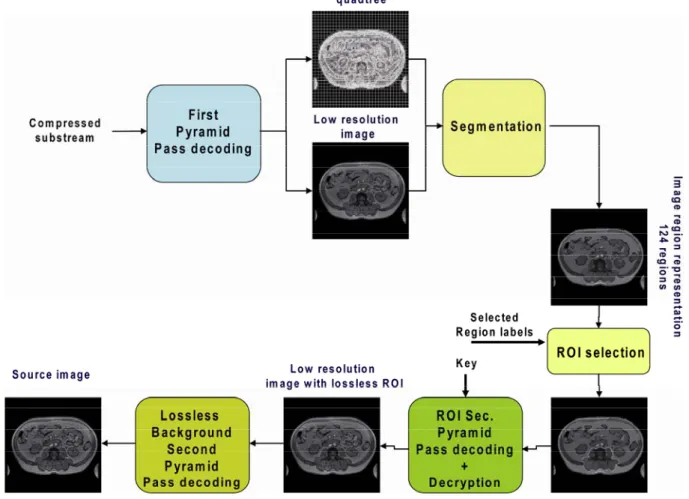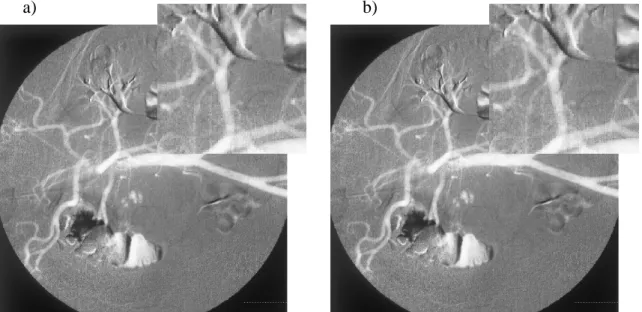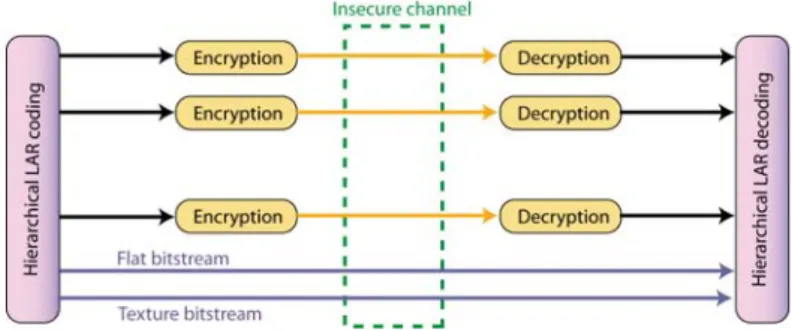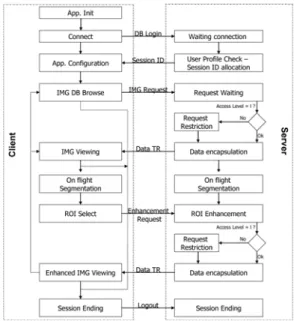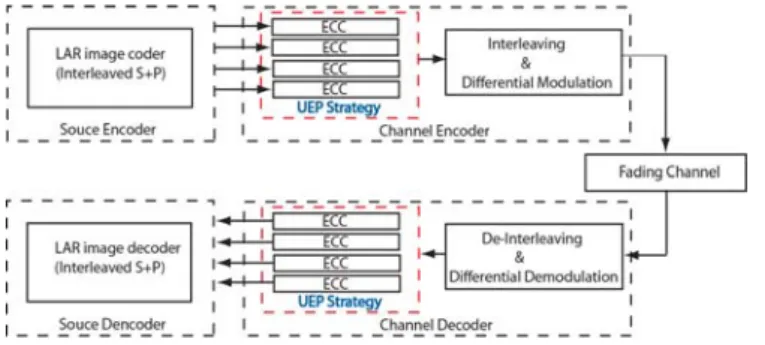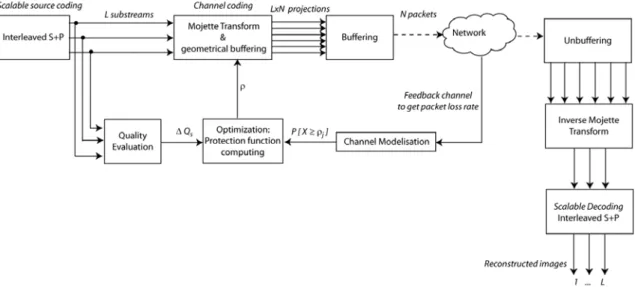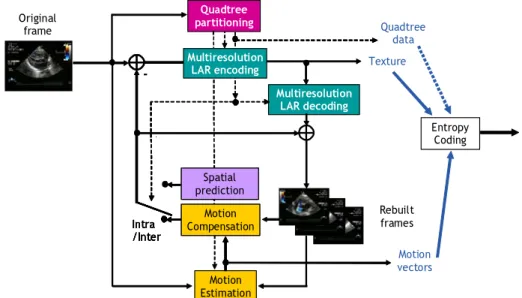HAL Id: hal-00464372
https://hal.archives-ouvertes.fr/hal-00464372
Submitted on 16 Mar 2010
HAL is a multi-disciplinary open access archive for the deposit and dissemination of sci-entific research documents, whether they are pub-lished or not. The documents may come from teaching and research institutions in France or abroad, or from public or private research centers.
L’archive ouverte pluridisciplinaire HAL, est destinée au dépôt et à la diffusion de documents scientifiques de niveau recherche, publiés ou non, émanant des établissements d’enseignement et de recherche français ou étrangers, des laboratoires publics ou privés.
WG1N5315 - Response to Call for AIC evaluation
methodologies and compression technologies for medical
images: LAR Codec
Marie Babel, Olivier Déforges, Laurent Bédat, François Pasteau, Clément
Strauss, Jean Motsch
To cite this version:
Marie Babel, Olivier Déforges, Laurent Bédat, François Pasteau, Clément Strauss, et al.. WG1N5315 - Response to Call for AIC evaluation methodologies and compression technologies for medical images: LAR Codec. 2010, pp.1-20. �hal-00464372�
ISO/IECJTC1/SC29/WG1N March 2010
ISO/IEC JTC1/SC29/WG1 (ITU-T SG8)
Coding of Still Pictures
JBIG
JPEG
Joint Bi-level Image Joint Photographic Experts Group Experts Group
TITLE: Response to Call for AIC evaluation methodologies and compression technologies for medical images: LAR Codec
SOURCE: IETR / INSA (France)
Marie Babel marie.babel@insa-rennes.fr Olivier Déforges olivier.deforges@insa-rennes.fr Clément Strauss clement.strauss@insa-rennes.fr François Pasteau francois.pasteau@insa-rennes.fr Laurent Bédat laurent.bedat@insa-rennes.fr Jean Motsch jean.motsch@st-cyr.terre.defense.gouv.fr
PROJECT: New work item AIC
STATUS: Technology Contribution
REQUESTED ACTION: For review and discussion
DISTRIBUTION: WG 1 members and public at large
Contact:
ISO/IEC JTC 1/SC 29/WG 1 Convener - Dr. Daniel T. Lee
Yahoo!, Rm 2802, Sunning Plaza, 10 Hysan Avenue, Causeway Bay, Hong Kong
1 Introduction
This document describes the IETR response to the specific call for contributions of medical imaging technologies to be considered for AIC.
The introduction of medical imaging management systems to hospitals (PACS : Picture Communication and Information System) is leading to the design of dedicated information systems to facilitate the access to images and provide additional information to help exploit and understand them. Implementing PACS requires an ad hoc protocol describing the way images are acquired, transferred, stored and displayed. DICOM (Digital Image Communications Management) provides a standard that specifies the way in which to manage these images [1].
The need for efficient image compression quickly becomes apparent. In particular, dataset size is exploding, because of the evolution of medical image acquisition technology together with changes in medical usage [2][3]. From the compression point of view, the challenge lies in finding coding solutions dedicated to the storage or communication of images and associated information that will be compliant with the memory and computation capacities of the final workstations.
The design of a new medical image compression scheme requires many dedicated services. Medical images usually go with private metadata that have to remain confidential. In particular, to insure reliable transfers, flexible and generic scheduling and identification processes have to be integrated for database distribution purposes to take account of secure remote network access together with future developments in network technologies. Fast browsing tools, including the segmentation process and scalability, are therefore needed.
This is the background against which IETR Laboratory proposes the content-based Locally Adaptive Resolution (LAR) codec. The LAR method has already been proposed as a response to the call for contributions of technologies [4]. In this document, we focus on medical image processing, and give some specific uses allowed by our compression systems.
The philosophy behind our coder is not to outperform JPEG2000 in compression; our goal is to propose an open source, royalty free, alternative image coder with integrated services. While keeping the compression performances in the same range as JPEG2000 but with lower complexity, our coder also provides services such as scalability, cryptography, data hiding, lossy to lossless compression, region of interest, free region representation and coding. 1
1
Acknowledgment: this work is supported by the French National Research Agency as part of the CAIMAN project (ANR-08-VERS-002).
2 The LAR codec: an overview
The LAR method was initially introduced for lossy image coding [5]. It is based on the assumption that an image can be represented as layers of basic information and local texture.
Hence, the LAR (Locally Adaptive Resolution) codec relies on a two-layer system (Figure 1) [5]. The first layer, called Flat coder, leads to construct a low bit-rate version of the image with good visual properties. The second layer deals with the texture that is encoded through a texture coder, aiming at visual quality enhancement at medium/high bit-rates. Therefore, the method offers a natural basic SNR scalability.
Figure 1 : General scheme of two-layer LAR coder
The LAR codec tries to combine both efficient compression in a lossy or lossless context and advanced functionalities and services. For this purpose, we defined three different profiles for user-friendly usage (Figure 2).
The baseline profile is dedicated to low bit-rate encoding. In the context of medical image compression, this profile is clearly not appropriate. As medical image compression requires lossless solutions, we then focus the discussion on functionalities and technical features provided by the pyramidal and extended profiles:
- functionalities: scalability, hierarchical region representation, adjustable profiles and complexity, lossy and lossless coding.
- services: cryptography, steganography, error resilience, hierarchical securized processes.
Figure 2: Specific coding parts for LAR profiles
3 Functionalities and associated uses
3.1 Pixel format supports
The LAR codec supports a wide range of image data formats, such as RGB, monochrome and all integer color transformed images, especially the ones based on luminance – chrominance decomposition.
For medical image compression purposes, one has to perform lossless colour compression. Although images are traditionally represented in RGB native format, transforming them into a more perceptual format is often worthwhile, in terms of both representation and coding. Reversible colour transformations from RGB space are required and we have therefore, for example, implemented YDbDr (RCT JPEG2000), YCoCg-R etc. Moreover, the LAR codec also defines Y (or monochrome) format solutions.
As the LAR codec is a fully unsigned integer-based compression scheme, it can support a wide range of pixel formats, from 8 bits per channel up to 32 bits per component. This feature allows its use with a very wide range of medical image compressions, from 8 bits to 32 bits unsigned integer bit depth from an MRI or PET scan for example. 16-bit fixed point and 32-bit fixed point image data can be handled by a lossless LAR codec.
For 32-bits float data, the lossless LAR codec will then directly interpret the IEEE-754 bit-pattern positive number as a 32-bit unsigned integer [6]. The negative float number implies three steps: removing the sign-bit, applying the casting operation then taking the complement of one. This transformation is fully reversible.
3.2 Lossy to lossless compression solution - Scalability
Scalable image decompression is an important feature in the medical field, which sometimes works with very large images. Scalability enables progressive image reconstruction by integrating successive compressed sub-streams in the decoding process.
Scalability is generally first characterized by its nature: resolution (multi-size representation) and/or SNR (progressive quality enhancement). Just like JPEG2000, the LAR codec supports both of them. The main difference is that the LAR provides multiresolution “edge oriented” quality enhancement. The lossy or lossless coding process involves two-pass dyadic pyramidal decomposition. The first pass, leading to a low bit-rate image, encodes the overall information in the image, preserving main contours, while smoothing homogeneous areas. The second pass adds the local texture in these areas.
The second important feature for scalability concerns granularity. Scalability granularity defines which elementary amount of data can be independently decoded. Among existing standards, JPEG2000 offers the finest grain scalability. On the other hand, JPEG provides no scalability at all (except in its progressive mode), while JPEG-XR enables two scalability levels. In LAR, the number of dyadic resolution levels N is adjustable, with two quality levels per resolution. Therefore, the number of elementary scalable sub-streams is 2N.
The first pyramid pass provides an image with variable-sized blocks. LAR also contains some interpolation / post-processing steps that can smooth homogeneous areas while retaining sharp edges.
3.3 Region / object representation and Region Of Interest (ROI)
Current image and video compression standards rely only on information theory. They are based on prediction and decorrelation optimization techniques without any consideration of source content. To get higher semantic representation, Kunt first introduced the concept of second generation image and video coding [7]. It refers to content-based representation and compression at region/object level. To obtain a flexible view with various levels of accuracy, a hierarchical representation is generally used, going from a fine level comprising many regions, to a coarse level comprising only a few objects.
Regions are defined as convex parts of an image sharing a common feature (motion, textures, etc). Objects are defined as entities with a semantic meaning inside an image. For region representation, two kinds of information are necessary: shape (contours) and content (texture). For video purposes, motion constitutes a third dimension.
The region-based approach tends to link digital systems and human vision as regards image processing and perception. This type of approach provides advanced functionalities such as interaction between objects and regions, or scene composition. Another important advantage is the ability, for a given coding scheme, of both increasing compression quality on highly visually sensitive areas of images (Region Of Interest) (ROI) and decreasing the compression quality on less significant parts (background). The actual limited bandwidth of channels compared to the data volume required for image transmission leads to a compromise between bit-rate and quality. Once the ROIs are defined and identified, this rate/quality bias can be not only generally but also locally adjusted for each ROI:
compression algorithms then introduce only low visual distortions in each ROI, while the image background can be represented with high visual distortions.
Despite the benefits of region-based approaches in terms of high level semantic description, some limitations to common techniques have restricted their use.
The first one is the generally limited compression performances achieved, due to the region description cost: most of the existing methods suggest sending a segmentation map from the coder to the decoder. As the number of regions increases, the overhead costs become significant.
The second limitation concerns complexity: most of the existing methods rely on complex segmentation processes. Despite increasing improvements in terms of processing performance, most of the state-of-the-art region / object representation techniques are still too time consuming.
3.3.1 Scalable ROI encoding for medical use
Designing semantic models becomes a key feature in medical image management [8]. Different scenarios can be investigated. We present only one scenario suitable for image storage and off-line decoding. This scenario involves the following processing steps.
1. At the coder side, the specialist defines the ROI in the image and chooses the option “lossless mode with encrypted ROI”. The resultant substream is given in Figure 3.
2. At the decoder side, the image can be partially decoded until the lossless ROI has been reconstructed or fully decoded. Figure 4 shows the overall process.
Figure 4: Overall decoding scheme for lossless compression with an encrypted ROI
3.3.2 LAR self-extracted region representation
LAR provides an unusual method for low cost region-level coding, based on the concept of self-extracting region representation. It consists of a segmentation process performed only from highly compressed images in both the coder and the decoder. This solution prevents costly transmission of the segmentation map to provide the region shapes. An original segmentation algorithm has been designed, leading to an efficient hierarchical region-based description of the image. The process ensures full compliance between the shape of regions and their content encoding. One direct issue is ROI coding: an ROI is rapidly and easily defined as a set of regions in either the coder or the decoder. Local image quality enhancement is then achieved by allowing the second pyramidal decomposition pass only for blocks inside the ROI. Another application of an ROI description is a full encryption process (see below), which can be applied only to the ROI.
The segmentation process is optional. It can be performed on-line or off-line. From a complexity point of view, the segmentation process is of low complexity compared with common segmentation techniques. The main reason is that the LAR segmentation process starts from the block-level representation, given by the quadtree, instead of elementary pixels. The segmentation has been pipelined and implemented onto multicore platforms [9].
transmitting the binary ROI map. The corresponding cost is limited, as ROIs are described at block-level: a full region-map composed of 120 regions is encoded at around 0.07 bpp, whereas the cost of a binary ROI image, whatever the ROI shape, is less than 0.01 bpp.
JPEG2000 also proposes ROI functionality, but its solution significantly differs from the LAR one. To sum up, ROI in LAR has improved features, for example:
- ROI can represent any shape,
- ROI enhancement accurately matches the shape,
- the encoding cost of the shape is insignificant (a few bytes), - several ROIs can be defined in the same image,
- any quality ratio between ROI and background can be defined,
- ROI can be fully encrypted, while background can be partially or not encrypted.
3.4 Content protection features
Whatever the storage or channel transmission used, medical applications require secure transmission of patient data. Embedding them in an invisible way within the image itself remains an interesting solution.
We also deal with security concerns by encrypting the inserted data. Whereas the embedding scheme can be made public, the use of a decryption key will be mandatory to decipher the inserted data.
3.4.1 Steganography
Data embedding is one of the new services expected within the framework of medical image compression. It consists of hiding data (payload) in a cover image. Applications of data embedding range from steganography to metadata insertion. They differ in the amount of data to be inserted and the degree of robustness to hacking.
From a signal processing point of view, it uses the image as a communication channel to transmit data. The capacity of the channel for a specific embedding scheme gives the size of the payload that can be inserted. A fine balance has to be achieved between this payload and the artefacts introduced in the image. This being so, different embedding schemes are compared on a payload vs. PSNR basis. Of course, the overall visual quality can be assessed.
The target application is the storage of data related to a given medical image. That data can consist of patient ID, time stamps, or the medical report, transcribed or in audio form. The idea is to avoid having to store several files about specific images by having all the necessary information directly stored within the image data.
We therefore propose a data embedding service that aims to insert a high payload in an image seen either as a cover or a carrier, such as a medical report in audio form. For this purpose, audio data, after coding and ciphering, is inserted in a corresponding medical image. The embedded image is then transmitted using usual channels. Of course, this scheme is compliant with any error protection framework that might be used. When retrieval of audio
data is requested, the data embedding scheme is reversed, and both the original image and the audio data are losslessly recovered. To avoid significant perceptually distortions, the data hiding mapping is powered by the quadtree: distortions are less perceptible in homogeneous areas than upon edges.
We show preliminary results on an angiography 512-squared medical image (Figure 5). A payload of 63598 bits is inserted, with a PSNR of 40 dB. Considering a 1 MP image, the payload can be up to 300 kbits. It corresponds roughly to an audio message of 200 s when using a 1.5kbits voice compression rate. Of course, as many images are taken during the same medical examination, the length of the corresponding audio files is extended. Our embedding scheme is an efficient adaptation of a useful technique to our image coder. It performs well, allowing high payload and minimum distortion.
From a compression point of view, the data hiding process does not affect the coding efficiency: the total coding cost is about equal to the initial lossless encoding cost of the source image plus the inserted payload.
a) b)
Figure 5: a) Source image - b) Image with inserted payload
3.4.2 Cryptography
Besides watermarking, steganography, and techniques for assessing data integrity and authenticity, the provision of confidentiality and privacy for visual data is one of the most important topics in the area of multimedia security in the medical field. Image encryption lies somewhere between data encryption and image coding. Specifically, as the amount of data to be considered is several orders of magnitude greater than the amount for ordinary data, more challenges are to be dealt with. The main challenge is the encryption speed, which can be a bottleneck for some applications in terms of computation time or in terms of computer resources required. A secondary challenge is to maintain the compliance of the encrypted bitstream with the chosen image standard used to compress it.
scheme is based mainly on the following idea: the quadtree used to partition the image is necessary to rebuild the image. This has been backed up by theoretical and experimental work. As a result, the quadtree partition can be considered to be the key itself, and there is no need to encrypt the remaining bitstream.
The key obtained is thus as long as usual encryption key and its security has been shown to be good. If further security is requested, the quadtree partition can be ciphered using a public encryption scheme, to avoid the transmission of an encryption key, as depicted in Figure 6 [10]. This system has the following properties: it is embedded in the original bit-stream at no cost, and allows for multilevel access authorization combined with a state-of-the-art still picture codec. Multilevel quadtree decomposition provides a natural way to select the quality of the decoded picture.
Figure 6: LAR hierarchical selective encryption principle
Selective encryption goes a bit further than partial encryption. The idea is to cipher only a small fraction of the bitstream, the main component, which gives the added advantage of obtaining a valid compliant bitstream. This property allows the user to see a picture even without the key. Of course, the picture must be as different to the original one as possible.
Our selective encryption scheme uses also the quadtree partition as a basis [11]. The data required in the compression framework to build the flat picture are also used. The general idea is to encrypt several levels of the hierarchical pyramid. The process begins at the bottom of the pyramid. Depending on the depth of the encryption, the quality of the image rebuilt without the encryption key varies. The encryption itself is performed by a well-known secure data encryption scheme. One main property of our selective encryption scheme is that the level of encryption (i.e. the level of the details remaining visible to the viewer) can be fully customized. Hierarchical image encryption is obtained by deciding which level will be decrypted by supplying only the keys corresponding to those levels. This refines the quality of the image given to different categories of viewers. The encryption of a given level of the partition prevents the recovery of any additional visually-significant data. From a distortion point of view, it appears that encrypting higher levels (smaller blocks) increases the PSNR, and at the same time, the encrypting cost. From a security point of view, as the level increases, the search space for a brute force attack increases drastically.
As our research is focused on fast encryption procedures specifically tailored to the target environment, we use the pyramidal profile with Interleaved S+P configuration. Our encryption tools allow a fine selection of tradeoffs between encryption computing cost,
hierarchical aspects, compliance and the quality of encrypted pictures.
3.4.3 Client-server application and hierarchical access policy
For medical use, together with PACS systems, images and videos databases are a powerful collaborative tool. However, the main concern when considering these applications lies in the secure accessing of images. The objective is therefore to design a medical image database accessible through a client-server process that includes and combines a hierarchical description of images and a hierarchical secured access.
We are currently working on a corresponding client-server application [12]. Every client will be authorized to browse the low-resolution image database and the server application will verify the user access level for each image and ROI request. ROIs can be encrypted or not, depending on the security level required.
If a client application sends a request that does not match the user access level, the server application will reduce the image resolution according to access policy. The exchange protocol is depicted in Figure 7.
Figure 7: Exchange protocol for client-server application
3.5 Transmission error protection – error resilience
Interest in remote medical applications has been rapidly increasing. Telemedicine aims to speed up the diagnosis process, reduce risks of infection or failure, enhance mobility and reduce patient discomfort.
Although wire networks are traditionally used for teleradiology or telesurgery purposes, the rapid growth of wireless technologies provides new potential for remote applications. To ensure optimal visualization of transmitted images, there are two possible ways of protecting the bitstreams.
Firstly, protecting the encoded bit-stream against error transmission is required when using networks with no guaranteed quality of service (QoS). In particular, the availability of the information can be ensured by the Internet protocol (IP). We focused our studies on two
topics, namely the loss of entire IP packets and the transmission over wireless channel. Secondly, we develop error resilience strategies adapted to our compression scheme. UEP solutions used together with proper resynchronization processes and robust encoding naturally leads to optimal conditions for the transmission of sensitive data.
3.5.1 UEP strategies
Limited bandwidth and distortions are the main features of a wireless channel. Therefore, both compression and secure transmission of sensitive data are simultaneously required. The pyramidal version of the LAR method and an Unequal Error Protection strategy are applied respectively to compress and protect the original image. The UEP strategy takes account of the sensitivity of the substreams requiring protection and then optimizes the redundancy rate. In our application, we used the Reed Solomon Error Correcting Code RS-ECC, mixed with symbol block interleaving for simulated transmission over the COST27 TU channel [13] (Figure 8). When compared to the JPWL system, we show that the proposed layout is better than the JPWL system, especially transmission conditions are bad (SNR<21 dB).
Other simulation tests have been designed for MIMO systems using a similar framework, and have shown the ability of our codec to be easily adapted to bad transmission conditions, while keeping reasonable additional redundancy. At this point, comparisons with other methods remain difficult. Both SISO and MIMO transmissions simulation tools were provided by the French X-LIM Laboratory [14].
Current developments are focused on the study of the LTE transmission system [15], and its combination with LAR coded bitstreams.
These preliminary tests have been carried out without implementing basic error resilience features, such as resynchronization process, that should greatly improve our results. Some related solutions are presented below.
Figure 8 : Overall layout of the multi-layer transmission/compression system.
In other words, compensating IP packet loss also requires a UEP process, which uses an exact and discrete Radon transform, called the Mojette transform [16]. The frame-like definition of this transform allows redundancies that can be further used for image description and image communication (Figure 9), for QoS purposes.
Figure 9: General joint LAR-Mojette coding scheme
3.5.2 Error resilience
When only considering source coding, some simple adapted solutions of error resilience can be implemented. Introducing resynchronization markers remains the easiest way of adding error resilience to an encoding process. In this respect, the idea is to adapt marker definition to the used entropy coder.
Although generic markers that fit any entropy encoder can be implemented, we have designed specific markers adapted to our particular Q15 coder together with the LAR bistream organization. Hence, different intra and inter substream markers have been defined. These distinct markers can also be used as stream identifiers to design an intelligent resynchronization process: if we consider entire IP packet loss, the system is automatically able to identify the lost packet and ask for its retransmission.
As previously mentioned, these error resilience techniques can be coupled with UEP strategies, for optimal protection features.
3.6 Partial decoding
Partial coding/decoding refers to methods able to provide some partial coding features from only a part of the data. Partial decoding can generally be used to decrease decoding complexity and delay. Partial decoding efficiency can be evaluated when considering the amount of partially decoded data and the resultant available features. In the LAR codec, partial decoding addresses two aspects: compression and encryption. From the compression point of view, partial decoding matches the notion of scalability, whereas for encryption, it corresponds to the encryption process applied only to a subset of data. Both aspects are detailed below.
3.7 Adjustable complexity
Although most of diagnostic processes are performed using traditional PC workstations, new mobile solutions have been developed for remote medical monitoring. These portable solutions involve limited capacities in terms of memory or computational complexity for the terminal.
The modularity of our scheme authorizes a new level of scalability in terms of complexity, depending closely on the chosen profile. Scalability is obtained when considering the different algorithmic solutions available. In particular, one bottleneck in our method lies in the entropy coder. To adjust the computation complexity, one solution consists of choosing an appropriate entropy coder.
The IETR laboratory also aims to provide automatic solutions of fast prototyping onto heterogeneous architecture (DSPs, FPGAs), using Algorithm Architecture Matching methodology. Consequently, if the LAR codec has been developed on PCs, we can easily implement different LAR versions on embedded systems.
Previous works were dedicated to the fast development and implementation of distributed LAR image compression frameworks on multi-components for flat LAR [17], or for extended profiles with the proper region description defined in the extended profile, using cosimulation approaches [9]. For these embedded versions, we used the Golomb-Rice coder as we do for the entropy coder, because of its lower complexity.
We presented in [18] a dedicated FPGA implementation of the FLAT LAR image coder. This coding technique is particularly suitable for low bit-rate compressions. From an image quality point of view, the FLAT LAR presents better results than JPEG, while implementation resource requirements are similar. Internal architecture has been designed as a set of parallel and pipelined stages, enabling full image processing during a single regular scan. The architecture latency is extremely low as it is determined by the data acquisition for one slice of 8 lines.
3.8 Video and multi-frame extension
Although still images are mostly obtained from acquisition devices, videos or multi-frame are used especially for cardiac XA CD, endoscopy or ultrasound data. As a consequence, for telemedicine purposes, two ways of using videos can be foreseen. Lossless video coding is typically required for storage use, whereas region-based coding can be useful for telediagnosis purposes.
For both solutions, we have designed dedicated solutions. In this document, we only give basic features of the lossless compression scheme. Information on LAR time-consistent region-based coding scheme can be found in [19].
In [20], we presented a lossless video and multi-frame compression solution. The chosen framework is depicted in Figure 10. In order to reap the benefits of semantic scalability and the context modelling of the LAR codec, quadtree partition is here directly applied on each image of the video sequence. The lossless compression of the residual error is then obtained when carrying out a full pyramidal decomposition. Joint use of the video coding scheme and predictive scalable approach aims to meet two fundamental requirements. On one hand, an algorithm with resolution and quality scalability is proposed. On the other hand, the user has
at his disposal a simple and unified solution for both lossless and lossy compression. Original frame Entropy Coding Quadtree data Motion vectors Quadtree partitioning Multiresolution LAR decoding --Motion Estimation Rebuilt frames Spatial predictionSpatial prediction Intra /Inter Intra /Inter Intra /Inter Intra /Inter Texture Multiresolution LAR encoding Motion CompensationMotion Compensation
Figure 10: Lossless video compression framework
4 Complementary technical features
4.1 Characteristics of the LAR encoding method – Adaptative quadtree
decomposition
The LAR (Locally Adaptive Resolution) codec relies on a two-layer system (Figure 1) [5]. The first layer, called Flat coder, constructs a low bit-rate version of the image with good visual properties. The second layer deals with the texture that is encoded through a texture coder, aimed at visual quality enhancement at medium/high bit-rates. Therefore, the method offers a natural basic SNR scalability.
The basic idea is that local resolution, in other words pixel size, can depend on local activity, estimated through a local morphological gradient. This image decomposition into two sets of data is thus performed conditionally to a specific quadtree data structure, encoded in the Flat coding stage. Thanks to this type of block decomposition, their size implicitly gives the nature of the given block: smallest blocks are located upon edges whereas large blocks map homogeneous areas. Then, the main feature of the FLAT coder consists of preserving contours while smoothing homogeneous parts of the image.
This quadtree partition is the key system of the LAR codec. Consequently, this coding part is required whatever the chosen profile.
4.2 Pyramidal Profile
4.2.1 Multiresolution schemeTo both increase scalability capacity and address lossless compression, we have proposed multiresolution extensions of the basic LAR called Interleaved S+P [21] and RWHaT+P [22]. The overall approach used in these two techniques is identical; the only difference lies in the decomposition step. To fit the quadtree partition, dyadic decomposition is carried out. The first and second layers of the basic LAR are replaced by two successive pyramidal decomposition processes. However the image representation content is preserved: the first decomposition reconstructs the low-resolution image (block image) while the second one processes local texture information (Figure 11). These methods provide both increasing scalability and an efficient lossy to lossless compression solution.
Some integer wavelet kernels fit these requirements. We then introduced the Interleaved S+P technique as an improved version of S+P by increasing space prediction. As for the RWHaT solution, it is based on a reversible transform 2D WHT, performing the inverse rounding operation to recover actual real transformed values, and secondly by carrying out the inverse transform for 2x2 blocks.
Figure 11: LAR pyramidal decomposition
In the pyramidal profile, we mainly use the arithmetic coding scheme or its binary derivatives for prediction error encoding. The original structure of the LAR codec leads to automatically producing context modelling, allowing reduced zeroth order entropy cost. When adding specific inter-classification methods, the compression efficiency can be greatly increased [23][24].
4.2.2 Entropy coder and error resilience
To adjust the required computational complexity of our system, we then simply adapt the classic Golomb-Rice coder, for low complex application, and the arithmetic coder, or adaptive MQ like coder, or adaptive Q15 coder, for better compression results. A semi-adaptative Huffman coder is also available. One-pass solution can be implemented with an a priori codebook: for medical images of same type (e.g. mammograms) which share the same statistics, a unique codebook can be used. Two-passes methods lead to build an adapted codebook, so that to reduce the final rate. If exact codebook is computed from real errors, two solutions can be envisaged to transmit this codebook to the decoder. First, the entire codebook can be sent, implying a natural consequent overhead. Secondly, the codebook can be efficiently estimated from five different parameters, which characterized the distribution law of the codebook symbols.
Moreover, internal error detection is freely realized thanks to the introduction of forbidden codewords within the Huffman coder.
Online entropy decoding can also take advantage of the properties of the coded residual errors. These errors are naturally bounded by the adaptive quadtree decomposition. As soon as this bound is not respected, an error can be detected. Thus an intrinsic MQF like decoding process [25] is also available for free.
In terms of complexity, the Q15-LAR coder is 2.5 times faster than the arithmetic coder, and the semi-adaptive Huffman coder is 2 times faster than the Q15-LAR coder.
4.3 Extended Profile
4.3.1 Hierarchical colour region representation and coding
For colour images, we have designed an original hierarchical region-based representation technique adapted to the LAR coding method. An initial solution was proposed in [5]. To avoid the prohibitive cost of region shape descriptions, the most suitable solution consists of performing the segmentation directly, in both the coder and decoder, using only a low bit-rate compressed image resulting from the flat coder (or first partial pyramidal decomposition). Natural extensions of this particular process have also made it possible to address medium and high quality encoding and the region-level encoding of chromatic images. Another direct application for self-extracting region representation is found in a coding scheme with local enhancement in Regions Of Interest (ROI). Actual works aim at providing a fully multiresolution version of our segmentation process: indeed this region representation can be connected to the pyramidal decomposition in order to build a highly scalable compression solution.
The extended profile also proposes the use of dedicated steganography and cryptography processes, which will be presented in next sections.
To sum up, the interoperability of coding and representation operations leads to an interactive coding tool. The main features of the LAR coding parts are depicted in Figure 12.
Figure 12: Block diagram of extended LAR coder profile
4.3.2 Steganography
Difference Expansion (DE) is a method introduced by Tian [26] that embeds one bit per pixel pair based on S Transform. As the LAR Interleaved S+P algorithm and DE both use S-Transform during their computation, we have combined both techniques to perform the data insertion without degrading coding performance. In order to adjust the DE algorithm to LAR Interleaved S+P, some minor modifications are introduced compared with the original DE method. In particular, we power the insertion process by the quadtree partition, which means that the insertion is dependent on the image content. Another important improvement is that in the initial DE method, positions of possible “extensible” difference have to be encoded, adding a significant overhead. In our coding scheme, these positions can be directly deduced from the quadtree, and are then not transmitted.
5 Conclusion
In this document, we have described the LAR codec and its preliminary associated performance. This algorithm also provides different functionalities and services, such as scalability, region-level handling, steganography, cryptography, robustness and adjustable complexity. In this document, we especially showed the matching of our coding solution to medical applications and services.
Consequently, the LAR method contributes both technologies and evaluation methodologies for JPEG-AIC for the purposes of medical image processing.
6 Patent policy
The LAR coding system is not dependent on any patent. The source code is under LGPL license.
[1] B. Gibaud, “The DICOM standard : a brief overview,” Molecular imaging: computer reconstruction and practice, 2008, pp. 229-238.
[2] D. Clunie, “DICOM Support for Compression Schemes - More than JPEG,” 5th Annual Medical Imaging Informatics and Teleradiology Conference, USA: 2009.
[3] D. Clunie, “Dicom Research Applications, Life at the Fringe of Reality,” SPIE Medical Imaging, USA: 2009.
[4] M. Babel et O. Déforges, “Response to Call for AIC evaluation methodologies and compression technologies: LAR Codec,” 2009.
[5] O. Deforges, M. Babel, L. Bedat, et J. Ronsin, “Color LAR Codec: A Color Image Representation and Compression Scheme Based on Local Resolution Adjustment and Self-Extracting Region Representation,” Circuits and Systems for Video Technology, IEEE Transactions on, vol. 17, 2007, pp. 974-987.
[6] T. Richter, “Evaluation of Floating Point Image Compression,” IEEE International Conference on Image Processing, Cairo, Egypt: 2009, pp. 1909-1912.
[7] M. Kunt, A. Ikonomopoulos, et M. Kocher, “Second Generation Image Coding Techniques,” Proceedings of the IEEE, vol. 73, Avr. 1985, pp. 549–575.
[8] L. Temal, M. Dojat, G. Kassel, et B. Gibaud, “Towards an ontology for sharing medical images and regions of interest in neuroimaging,” Journal of Biomedical Informatics, vol. 41, Oct. 2008, pp. 766-778.
[9] E. Flécher, M. Raulet, G. Roquier, M. Babel, et O. Déforges, “Framework For Efficient Cosimulation And Fast Prototyping on Multi-Components With AAA Methodology: LAR Codec Study Case,” 15th European Signal Processing Conference (Eusipco 2007) 15th European Signal Processing Conference (Eusipco 2007) , Poznań Pologne : 2007, pp. ISBN: 978-83-921340-2-2 .
[10] J. Motsch, O. Déforges, et M. Babel, “Embedding Multilevel Image Encryption in the LAR Codec,” IEEE Communications International Conference , 2006, p. 4 .
[11] C. Fonteneau, J. Motsch, M. Babel, et O. Déforges, “A Hierarchical Selective Encryption Technique in a Scalable Image Codec,” Proc. of International Conference in Communications International Conference in Communications , Bucharest, Romania: 2008, pp. 1-4 .
[12] M. Babel, O. Deforges, L. Bedat, et J. Motsch, “Context-Based Scalable Coding and Representation of High Resolution Art Pictures for Remote Data Access,” Multimedia and Expo, 2007 IEEE International Conference on, 2007, pp. 460-463.
[13] W. Hamidouche, C. Olivier, M. Babel, O. Déforges, H. Boeglen, et P. Lorenz, “LAR Image transmission over fading channels: a hierarchical protection solution,” Proceedings of CTRQ'09 The Second International Conference on Communication Theory, Reliability, and Quality of Service , Colmar, France: 2009, pp. 1-4 .
[14] H. Boeglen, “IT++ library for numerical communications simulations,” http://herve.boeglen.free.fr/ itpp_windows/.
[15] C. Mehlführer, M. Wrulich, J.C. Ikuno, D. Bosanska, et M. Rupp, “Simulating the Long Term Evolution Physical Layer,” Proc. of the 17th European Signal Processing Conference, 2009.
[16] M. Babel, B. Parrein, O. Déforges, N. Normand, J. Guédon, et V. Coat, “Joint source-channel coding: Secured and progressive transmission of compressed medical images on the Internet,” Computerized Medical Imaging and Graphics, vol. 32, Juin. 2008, pp. 258-269.
[17] M. Raulet, M. Babel, O. Deforges, J. Nezan, et Y. Sorel, “Automatic coarse-grain partitioning and automatic code generation for heterogeneous architectures,” Signal Processing Systems, 2003. SIPS 2003. IEEE Workshop on, 2003, pp. 316-321.
[18] O. Déforges et M. Babel, “LAR method: from algorithm to synthesis for an embedded low complexity image coder,” 3rd International Design and Test Workshop 3rd International Design and Test Workshop,
IDT'08 , Monastir Tunisie : 2008, pp. 1-4 .
[19] E. Flécher, M. Babel, O. Déforges, et V. Coat, “LAR Video: Hierarchical Representation for Low Bit-Rate Color Image Sequence Coding,” Proc. of Picture Coding Symposium (PCS'07) Picture Coding Symposium (PCS'07) , Lisboa Portugal : 2007, p. paper 1175 .
[20] E. Flécher, S. Amir, M. Babel, et O. Déforges, “LAR Video : Lossless Video Coding with Semantic Scalability,” ICSES 2006 International Conference on Signals and Electronic Systems , ICSES , 2006, pp. 227-230 .
[21] M. Babel, O. Deforges, et J. Ronsin, “Interleaved S+P pyramidal decomposition with refined prediction model,” Image Processing, 2005. ICIP 2005. IEEE International Conference on, 2005, pp. II-750-3. [22] O. Deforges, M. Babel, L. Bedat, et V. Coat, “Scalable lossless and lossy image coding based on the
RWHaT+P pyramid and the inter-coefficient classification method,” Multimedia and Expo, 2008 IEEE International Conference on, 2008, pp. 185-188.
[23] F. Pasteau, M. Babel, O. Déforges, et L. Bédat, “Interleaved S+P Scalable Coding with Inter-Coefficient Classification Methods,” Proc. of the EUSIPCO'08 European Signal Processing Conference, EUSIPCO , Lausanne Suisse : 2008, pp. 1-5 .
[24] O. Déforges, M. Babel, et J. Motsch, “The RWHT+P for an improved lossless multiresolution coding,” EUSIPCO proceedings , 2006, p. nc .
[25] M. Grangetto, E. Magli, et G. Olmo, “A syntax-preserving error resilience tool for JPEG 2000 based on error
correcting arithmetic coding,” IEEE Trans. on Image Processing, vol. 15, Avr. 2006, pp. 807-818. [26] J. Tian, “Reversible data embedding using a difference expansion,” IEEE Transactions on Circuits and



